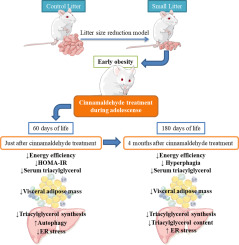The Journal of Nutritional Biochemistry ( IF 4.8 ) Pub Date : 2019-12-11 , DOI: 10.1016/j.jnutbio.2019.108321 Jessika Geisebel Oliveira Neto 1 , Silvia Karl Boechat 1 , Juliana Santos Romão 1 , Carmen Cabanelas Pazos-Moura 2 , Karen Jesus Oliveira 3

|
Nutrition at early stages of life contributes to the alarming incidence of childhood obesity, insulin resistance and hepatoesteatosis. Cinnamaldehyde, major component of cinnamon, increases insulin sensitivity and modulates adiposity and lipid metabolism. The aim of this study was to analyze the impact of cinnamaldehyde treatment during adolescence in a rat model of early obesity. Litter size reduction was used to induce overfeeding and early obesity. At postnatal day 30 (adolescence), the male Wistar rats received cinnamaldehyde by gavage (40 mg/kg of body weight/day) for 29 days and were studied at the end of treatment at 60 days old or 4 months thereafter (180 days old). At 60 days of age, the treatment with cinnamaldehyde promoted reduced visceral adiposity, serum triacylglycerol, and attenuation of energy efficiency and insulin resistance. In the liver, it reduced lipid synthesis, stimulated autophagy and reduced ER stress. At 180 days of age, animals treated with cinnamaldehyde during the adolescence exhibited normalization of visceral adiposity and energy efficiency, and attenuation of hyperphagia, serum hypertriglyceridemia and hepatic triacylglycerol content, with molecular markers indicative of reduced hepatic synthesis. However, the beneficial effect observed at 60 days of age on glucose homeostasis, autophagy and ER stress was lost. Therefore, the cinnamaldehyde supplementation during the adolescence has short- and long-term metabolic beneficial effects, highlighting its potential as an adjuvant in the treatment of early obesity.
中文翻译:

肉桂醛治疗可减轻早期肥胖大鼠肝脏中的内脏脂肪,并调节脂质代谢,自噬和内质网应激。
生命早期阶段的营养使儿童肥胖,胰岛素抵抗和肝脂肪变性的发生率令人震惊。肉桂醛是肉桂的主要成分,可增加胰岛素敏感性并调节肥胖和脂质代谢。这项研究的目的是分析青春期大鼠模型在早期肥胖中肉桂醛治疗的影响。减少产仔数可引起过度摄食和早期肥胖。在出生后第30天(青春期),雄性Wistar大鼠通过管饲法(40 mg / kg体重/天)接受肉桂醛治疗29天,并在治疗结束时60天或4个月大时(180天)进行了研究。 )。在60天龄时,肉桂醛治疗可促进内脏脂肪减少,血清三酰甘油减少,并降低能量效率和胰岛素抵抗。在肝脏中,它减少脂质合成,刺激自噬并减少内质网应激。在180天大的时候,青春期接受肉桂醛治疗的动物表现出内脏脂肪和能量效率的正常化,吞咽困难,血清高甘油三酯血症和肝三酰甘油含量降低,其分子标志物指示肝脏合成减少。但是,失去了在60天龄时对葡萄糖稳态,自噬和内质网应激的有益作用。因此,青春期补充肉桂醛具有短期和长期的代谢有益作用,突显了其在早期肥胖症治疗中作为佐剂的潜力。在青春期接受肉桂醛治疗的动物表现出内脏脂肪和能量效率的正常化,以及食欲减弱,血清高甘油三酯血症和肝三酰甘油含量降低,且分子标志物指示肝脏合成减少。但是,失去了在60天龄时对葡萄糖稳态,自噬和内质网应激的有益作用。因此,青春期补充肉桂醛具有短期和长期的代谢有益作用,突显了其在早期肥胖症治疗中作为佐剂的潜力。在青春期接受肉桂醛治疗的动物表现出内脏脂肪和能量效率的正常化,以及食欲减弱,血清高甘油三酯血症和肝三酰甘油含量降低,其分子标志物指示肝脏合成减少。但是,失去了在60天龄时对葡萄糖稳态,自噬和内质网应激的有益作用。因此,青春期补充肉桂醛具有短期和长期的代谢有益作用,突显了其在早期肥胖症治疗中作为佐剂的潜力。失去了在60天龄时对葡萄糖稳态,自噬和内质网应激的有益作用。因此,青春期补充肉桂醛具有短期和长期的代谢有益作用,突显了其在早期肥胖症治疗中作为佐剂的潜力。失去了在60天龄时对葡萄糖稳态,自噬和内质网应激的有益作用。因此,青春期补充肉桂醛具有短期和长期的代谢有益作用,突显了其在早期肥胖症治疗中作为佐剂的潜力。











































 京公网安备 11010802027423号
京公网安备 11010802027423号